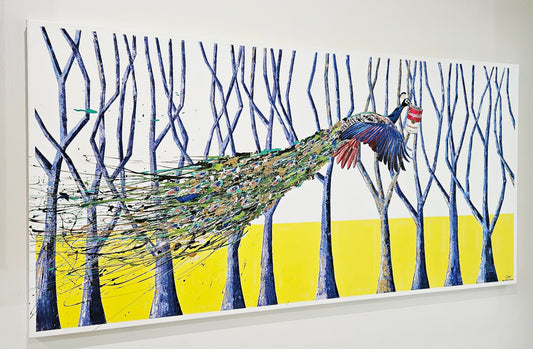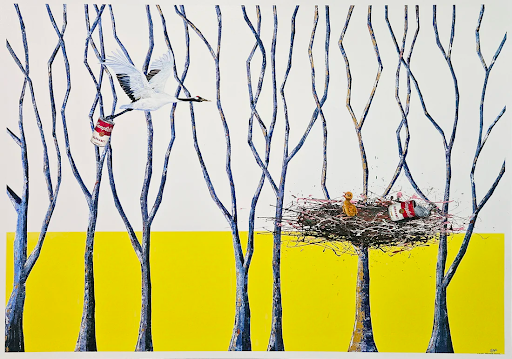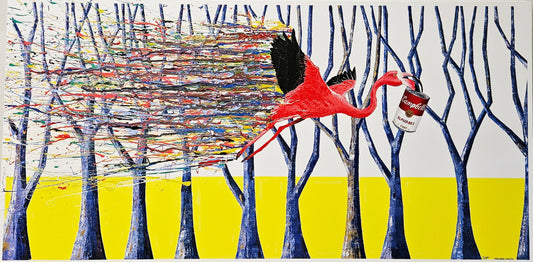Starship: A Vision of Space, Ambition, and the Human Condition in Modern Cubism

Starship by Haydn – A Modern Cubist Reflection on Space Travel and Human Exploration
In Starship, artist Haydn delivers a dynamic, contemplative work that speaks to both the technological achievements of our time and the enduring emotional impulse to explore. This powerful large-format painting, executed in oil paint and pastel, captures the duality of space exploration—the outward ambition of reaching beyond Earth and the internal transformation such a journey brings.
With its bold geometric forms and symbolic visual language, Starship is a monumental piece that bridges cubist aesthetics with contemporary cultural symbolism, anchoring it in art history and the zeitgeist of 21st-century progress.
A Narrative of Motion: Departure and Return
The composition of Starship is both visually compelling and emotionally charged. It centres around two distinctly styled spacecraft: one departing, sharp-edged and metallic, its form slicing through the air with clarity and intent; the other, returning, its outlines softened by time, suggesting that the journey has not only changed its shape but its spirit.
This duality forms the emotional core of the work. The departing ship represents hope, ambition, and curiosity, our collective desire to reach further, see more, and test the limits of our capabilities. The returning boat, in contrast, carries the weight of experience, endurance, and reflection. It’s a subtle acknowledgement that exploration is never without cost, all departures are touched by risk, and returns are never the same as the departure.
These visual elements reflect not only the journey into space but also the human emotional experience—how we embark on new paths with vision and return with stories, scars, and wisdom.
The Flag of Progress: Seven Gold Stripes
Seven horizontal gold stripes layered in bold, fragmented forms floating in the upper left quadrant of the canvas. These lines function both visually and symbolically. They echo the structure of a flag, perhaps an imagined emblem of human achievement—not one bound to nationality but to the shared identity of human aspiration.
With its associations of triumph, excellence, and reverence, gold becomes the visual language of progress. These stripes stretch and fragment across the composition, offering rhythm and movement while reinforcing the painting’s more profound message: that space exploration is not just a physical act but a symbolic one, an effort to assert meaning in the face of the vast, unknowing universe.
Some viewers might interpret these stripes as referencing the golden age of discovery; others may see them as a visual metaphor for time, with each stripe marking a milestone, an era, or an evolution in the human story.
The Influence of Modern Cubism: Multiplicity of Meaning
Haydn’s use of modern cubism is not merely stylistic. It challenges traditional perspectives and encourages viewers to consider multiple dimensions of meaning simultaneously. Starship expresses this through the layered planes, fractured forms, and non-linear spatial relationships.
Cubism, initially developed by Picasso and Braque to break down objects into their essential forms, is used here to reconstruct a complex narrative. The painting asks: what does progress look like? What do we lose and gain in the process of technological advancement? What does it mean to return from a journey different to how we began it?
These are philosophical questions embedded in visual language. The overlapping structures and fragmented space reflect the fragmented nature of identity, progress, and the idea of exploration in the digital age. It's not just about rockets and planets. It's about how we understand ourselves within the vastness.
Emotional Undercurrents: Space as Metaphor
While Starship draws inspiration from physical space travel and the futuristic architecture of spacecraft, it operates on a deeper, metaphorical level. The stars, the ships, the shimmering metallics—these are vehicles for discussing emotional journeys, intellectual pursuits, and the human compulsion to transcend limits.
The background is profoundly still, contrasted with the angular energy of the ships. This creates a moment of reflection, a reminder that exploration isn’t always loud or heroic. Sometimes, it’s quiet, internal, and even lonely.
The painting acknowledges this tension. It honours the drive to discover while recognising the solitude, silence, and unknowns accompanying such pursuits.
A Cultural Lens: Space Exploration and the Modern Myth
In recent years, space travel has dramatically re-entered public consciousness. Private companies like SpaceX have reimagined what was once the exclusive domain of government agencies. Missions to Mars are planned. The talk of colonising other planets has shifted from science fiction to tentative possibility.
Haydn’s Starship fits into this moment, not as a commentary on any single company or figure, but as a cultural artefact that reflects a new mythology, where technology is as much a symbol of identity as a tool of progress.
In classical mythology, the heavens were realms of gods and fate. Today, they are the next great frontier. Starship captures this evolving mythos and positions the viewer not as a passive observer but as part of the narrative as someone indirectly participating in a global conversation about ambition, resilience, and destiny.
The Physical Experience of the Painting
Standing in front of Starship in person, its scale and materiality are integral to the experience. At 200cm by 150cm, it occupies a space that demands physical and emotional engagement. The layered oil and pastel textures add depth that can’t be fully appreciated through images alone.
The surface reveals its complexity in stages: from a distance, the forms seem architectural and controlled; up close, the brushstrokes betray a human hand, the painter’s presence, the work of a mind negotiating ideas through colour, form, and emotion.
This balance between the impersonal and the intimate, the machine and the hand, is part of the artwork’s enduring tension and beauty.
Starship as an Ongoing Story
Starship does not provide answers. Like the universe it gestures toward, it remains open, suggestive rather than declarative, and meditative rather than didactic. It invites viewers to project their own meanings, consider their own journeys, and reflect on the universal themes of movement, change, and the human desire to reach beyond.
In its geometry, there is emotion. In its abstraction, there is a narrative. And in its stillness, there is an undeniable sense of motion of something just beginning or returning.
Starship is more than a painting of ships in space. It explores what it means to be human in a world where the boundaries of what is possible expand. It is about what we dream, what we build, and how we change as a result.
It is not just a vision of space. It is a vision of us.








